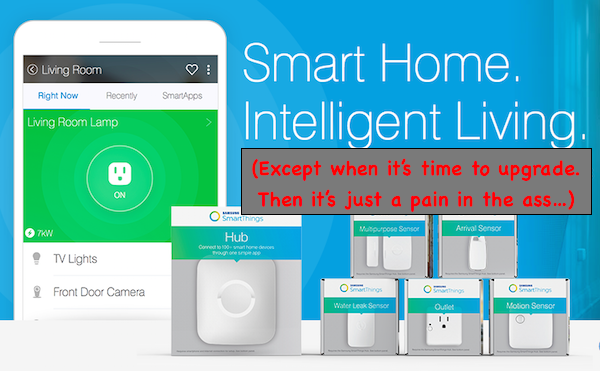On the Bleeding Edge: New Smart Home Headaches

For those who find the latest smart home technology irresistible, there’s been enough pain and suffering already, what with Revolv, Wink, and numerous other systems that have either bit the dust or have been plagued by swarms of bugs. But since the smart home is relatively new for many people, there’s a new pain-in-the-ass that’s lurking around the corner—lying in wait until the time is right to smack you right upside your early adopting head.
If you’re the owner of the original SmartThings Hub who has decided to upgrade to the new Samsung SmartThings Hub, you’ve already experienced—or will soon, once you receive the heavily backordered new Hub—the fistula inducing ordeal that changing out a smart home hub can be.
Lest you think I’m exaggerating things a bit, read the opening salvo of SmartThings’ five pages of instructions For the eleven steps it’s going to take to migrate your current setup to the new Version 2 Hub:
How to Migrate Your SmartThings Setup to Hub v2IMPORTANT: Every device connected to your v1 Hub will have to be individually and manually reset or excluded and then connected to Hub v2. You will also have to individually and manually delete all automations and SmartApps associated with your old Hub and then rebuild these configurations for your new setup. Depending on the number of devices in your home, this process can take several hours. Set aside enough time to complete the migration from start to finish.
I’m not sure “migration” is the right word here. It’s more like a “de-program and de-install before a complete re-install and full re-program” of the system. But if calling it a migration makes you feel better about the process, by all means, be my guest.
Switching to a new Hub isn’t too bad if your smart home system consists of a hub, a smart lock, and a light dimmer or two. But if you’ve installed numerous smart devices and crafted a lot of routines and schedules, you’re screwed. "Set aside enough time to complete the migration from start to finish.” Well, there went your weekend…
Don’t blame SmartThings, though. Right now, you’d face the same problem switching hubs from virtually any company. It’s simply the nature of the beast, and it’s something that has to change if the DIY smart home is going to graduate from being the plaything of the hardcore tinkerer to the must-have home improvement for the average person.
After all, smart home systems are supposed to make living in your home more convenient and more enjoyable, right?








































